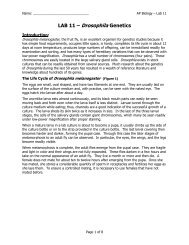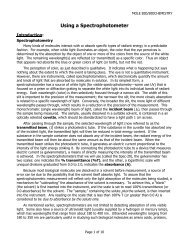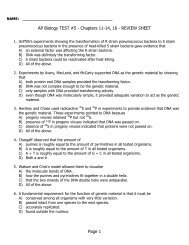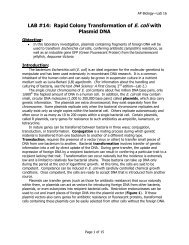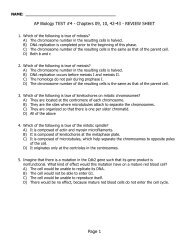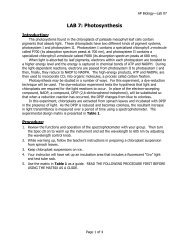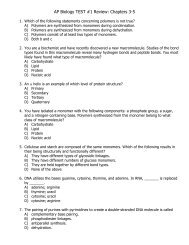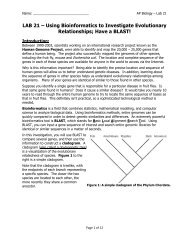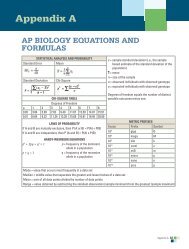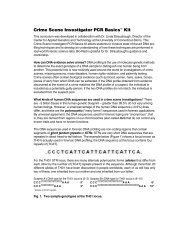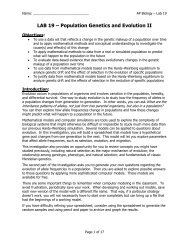LAB 21: Evolution and Classification
LAB 21: Evolution and Classification
LAB 21: Evolution and Classification
You also want an ePaper? Increase the reach of your titles
YUMPU automatically turns print PDFs into web optimized ePapers that Google loves.
Name: ______________________ AP Biology—Lab <strong>21</strong>evolved similar structures in response to similar environments or ways of life, not because theyshare a recent common ancestor. This is called convergent evolution because distantlyrelated species seem to converge in appearance (become more similar). Examples ofconvergent evolution include the wings of bats, birds <strong>and</strong> insects, or the streamlined shape ofwhales <strong>and</strong> fish. At first glance it might appear that whales are a type of fish. Upon furtherexamination it becomes apparent that this resemblance is superficial, resulting from the factthat whales <strong>and</strong> fish have adapted to the same environment. The presence of hair, the abilityto lactate <strong>and</strong> homeothermy clearly demonstrate that whales are mammals. Thus, thetaxonomist must take into account a whole suite of characteristics, not just a single one.The fossil record can also be helpful for constructing phylogenetic trees. For example, bearswere once thought to be a distinct group within the order Carnivora. Recently discoveredfossils, however, show that they actually diverged from the Canidae (wolves, etc.) fairlyrecently. The use of fossils is not without its problems, however. The most notable of these isthat the fossil record is incomplete. This is more of a problem for some organisms than others.For example, organisms with shells or bony skeletons are more likely to be preserved thanthose without hard body parts.The <strong>Classification</strong> <strong>and</strong> <strong>Evolution</strong> of Artificial OrganismsIn this lab you will develop a taxonomic classification <strong>and</strong> phylogenetic tree for a group ofimaginary organisms called Caminalcules after the taxonomist Joseph Camin who devisedthem. At the back of this packet are pictures of the 14 "living" <strong>and</strong> 58 "fossil" species that youwill use. Take a look at the pictures <strong>and</strong> note the variety of appendages, shell shape, colorpattern, etc. Each species is identified by a number rather than a name. For fossilCaminalcules there is also a number in parentheses indicating the geological age of eachspecimen in millions of years. Most of the fossil Caminalcules are extinct, but you will noticethat a few are still living (e.g. species #24 is found among the living forms but there is also a 2million year old fossil of #24 in our collection).The purpose of this lab is to illustrate the principles of classification <strong>and</strong> some of the processesof evolution (e.g. convergent evolution). We do these exercises with artificial organisms so thatyou will approach the task with no preconceived notion as to how they should be classified.This means that you will have to deal with problems such as convergent evolution just as ataxonomist would. With real organisms you would probably already have a pretty good idea ofhow they should be classified <strong>and</strong> thus miss some of the benefit of the exercise.Page 3 of 13




